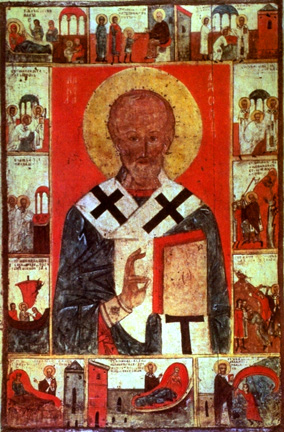| THE LEGEND OF ST NICHOLAS 
St. Nicholas, the patron saint of children, was born in Panthera in the province of Lycia, in Asia Minor in 326 A.D. Everyone knows the story of the poor merchant who had three daughters, and not enough money to marry them off. Rather than see the daughters sacrificed to "an infamous life," St. Nicholas went to their house on three successive nights, dropping bags of gold into the stockings which the girls had left to dry by the fire. The sisters found the gold and ever since, children have hung up stockings on Christmas Eve hoping that they will be filled with presents by Christmas morning. On the third night, the poor merchant waited for him, however. Catching the good saint in the act, the merchant thanked him for his good deed, promising never to reveal who had done this favor. But the fact that this is St. Nicholas' best-known act of charity indicates that someone must have told.
There is another, more bizarre story, however, connected to St. Nicholas. It takes place in Palestine, during the time of a terrible famine. As he was traveling through his diocese to visit and comfort his people, he lodged in the house of a certain host who was a son of Satan. This man, in the scarcity of provisions, was accustomed to steal little children, whom he murdered, and served up their limbs as meat to his guests. On the arrival of the bishop and his retinue, he had the audacity to serve up the dismembered limbs of these unhappy children before the man of God, who had no sooner cast his eyes on them than he was aware of the fraud. He reproached the host with his abominable crime, and going to the tub where their remains were salted down, he made over them the sign of the cross, and they rose up whole and well. The people who witnessed this great wonder were struck with astonishment (as indeed, they might well be), and the three children, who were the sons of a poor widow, were restored to their weeping mother. And so here is another reason that St. Nicholas became the patron saint of children, and the precursor of our modern day Santa Claus. St Nicholas was a Christian priest, who later became a bishop. He was a rich person, and traveled the country helping people, giving gifts of money and other presents. St Nicholas did not like to be seen when he gave away presents, so the children of the day were told to go to sleep quickly or he would not come! Nothing has changed and Santa Claus will not arrive this Christmas unless the children go to sleep early. Despite being quite young Nicholas had earned a reputation for kindliness and wisdom. In the year 303, the Roman emperor Diocletian commanded all the citizens of the Roman Empire, which included Asia Minor, to worship him as a god. Christians believed in one god and one god alone, so their conscience would not allow them to obey the Emperor's order. Angered by their stubbornness, Diocletian warned the Christians that they would be imprisoned. The Emperor carried out the threat and St Nicholas who resisted too was also imprisoned. For more than five years, St Nicholas was confined to a small cell. He suffered from cold, hunger, and thirst, but he never wavered in his beliefs. In 313, when Diocletian resigned, and Constantine came to power Nicholas was released, and he returned to his post as Bishop of Myra. He continued his good works and became even wiser and more understanding by the time of his death on December 6, 343. By 450, churches in Asia Minor and Greece were being named in honor of him. By 800, he was officially recognized as the a saint by the Eastern Catholic Church. In the 1200s, December sixth began to be celebrated as Bishop Nicholas Day in France. By end of the 1400s, St Nicholas was the third most beloved religious figure, after Jesus and Mary. There were more than 2,000 chapels and monasteries named after him. In the 1500s people in England stopped worshipping St Nicholas and favored more another gift giving figure, Father Christmas. Over the centuries, St Nicholas' popularity grew, and many people in Europe made up new stories that showed his concern for children. The name Santa Claus was derived from the Dutch Sinter Klass pronunciation of St Nicholas. Early Dutch settlers in New York (once called New Amsterdam) brought their traditions of St Nicholas. As children from other countries tried to pronunce Sinter Klass, this soon became Santa Klass, which was settled as Santa Claus. The old bishop's cloak with mitre, jewelled gloves and crozier were soon replaced with his red suit and clothing seen in other modern images. 
Animated Santa from Jo's World |
 Free Forum Hosting
Free Forum Hosting